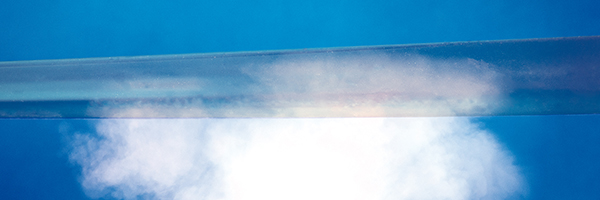Novel and highly productive process for robust layers on flexible materials

Film with a transparent barrier coat © Fraunhofer FEP | Picture in printable resolution: www.fep.fraunhofer.de/press
Wearables, arched displays and buildings facades increasingly require bendable, flexible surfaces with taylored functionality and properties. These coating functionalities include the reduction of gas permeation, protection against chemicals, radiation, and mechanical contact as well as conductive coatings and layers with specific optical properties.
Surfaces are equipped with thin functional layers to achieve these properties and functionalities. Increasing productivity and efficiency of these coating processes is an important focus of our applications-oriented research.
One of these deposition technologies is plasma-enhanced chemical vapor deposition. Fraunhofer FEP is active in the field of improved PECVD processes for high productivity and efficient application in roll-to-roll coating equipment. These processes provide large-area, cost-effective coating of flexible substrate material. In contrast to conventional processes, Fraunhofer FEP employs magnetrons and hollow-cathodes as plasma sources.
Michiel Top, Project Manager in the Flat and Flexible Products division at Fraunhofer FEP, is pleased with the results: “The development of our hollow-cathode PECVD process has provided us with a versatile tool for the deposition of silicon-containing plasma polymer layers on flexible substrates. The process not only allows us to scale up to web-widths up to four meters but can also be directly combined with other deposition techniques like sputtering and evaporation in a single facility.”
Dynamic coating rates of up to 3000 nanometers for 1 meter per minute web-speed have been attained for plasma polymer layers. This figure is about five to ten times higher compared to conventional processes like microwave PECVD. Plasma polymer layers deposited upon functional layers offer good protection against chemical attack (acids and salts) and against mechanical loading such as found in winding equipment when materials undergo additional roll-to-roll processing. It was shown that the water vapour transmittance of an inorganic barrier coating can be reduced by up to 50% by in-line deposition of a polymer-like protective layer.
This process allows for the deposition of taylored layer’s properties (composition, hardness, and refractive index) without losing the possibility to tune the dynamic coating rate within prescribed limits. In combination with sputter processing for example, this facilitates in-line deposition of multiple layers in a single pass for optical interference coating systems, saving process steps and therefore money.
The researchers see the next goal to be further improvement of both the process and the layers for various application scenarios, such as in flexible electronic components, through close cooperation with partners from industry such as machine builders and end-users. This way, transfer of the process towards the production level is targeted in the near future.
Fraunhofer FEP at 2018 FLEX:
Exhibition Booth: No. 5002
Presentations:
Wednesday, February 14, 2018: Session 12: FE Tools & Methods
12.2 B, 04:20 p.m., Michiel Top:
Application of high-rate PECVD for improved mechanical stability of Roll-to-roll anufactured flexible organic electronics
http://s.fhg.de/vUF
Thursday February 15, 2018: Session 17: Substrates
17.2 B, 10:40 a.m., Dr. Manuela Junghähnel:
Refinement of transparent conductive films on flexible glass by in-line flash-lamp annealing
http://s.fhg.de/Syt
Press Contact:
Annett Arnold
Head of Corporate Communications
Fraunhofer Institute for Organic Electronics, Electron Beam and Plasma Technology FEP
Phone +49 351 2586-333 | presse@fep.fraunhofer.de
Winterbergstr. 28 | 01277 Dresden | Germany | www.fep.fraunhofer.de
Media Contact
All latest news from the category: Trade Fair News
Newest articles

First-of-its-kind study uses remote sensing to monitor plastic debris in rivers and lakes
Remote sensing creates a cost-effective solution to monitoring plastic pollution. A first-of-its-kind study from researchers at the University of Minnesota Twin Cities shows how remote sensing can help monitor and…

Laser-based artificial neuron mimics nerve cell functions at lightning speed
With a processing speed a billion times faster than nature, chip-based laser neuron could help advance AI tasks such as pattern recognition and sequence prediction. Researchers have developed a laser-based…

Optimising the processing of plastic waste
Just one look in the yellow bin reveals a colourful jumble of different types of plastic. However, the purer and more uniform plastic waste is, the easier it is to…



